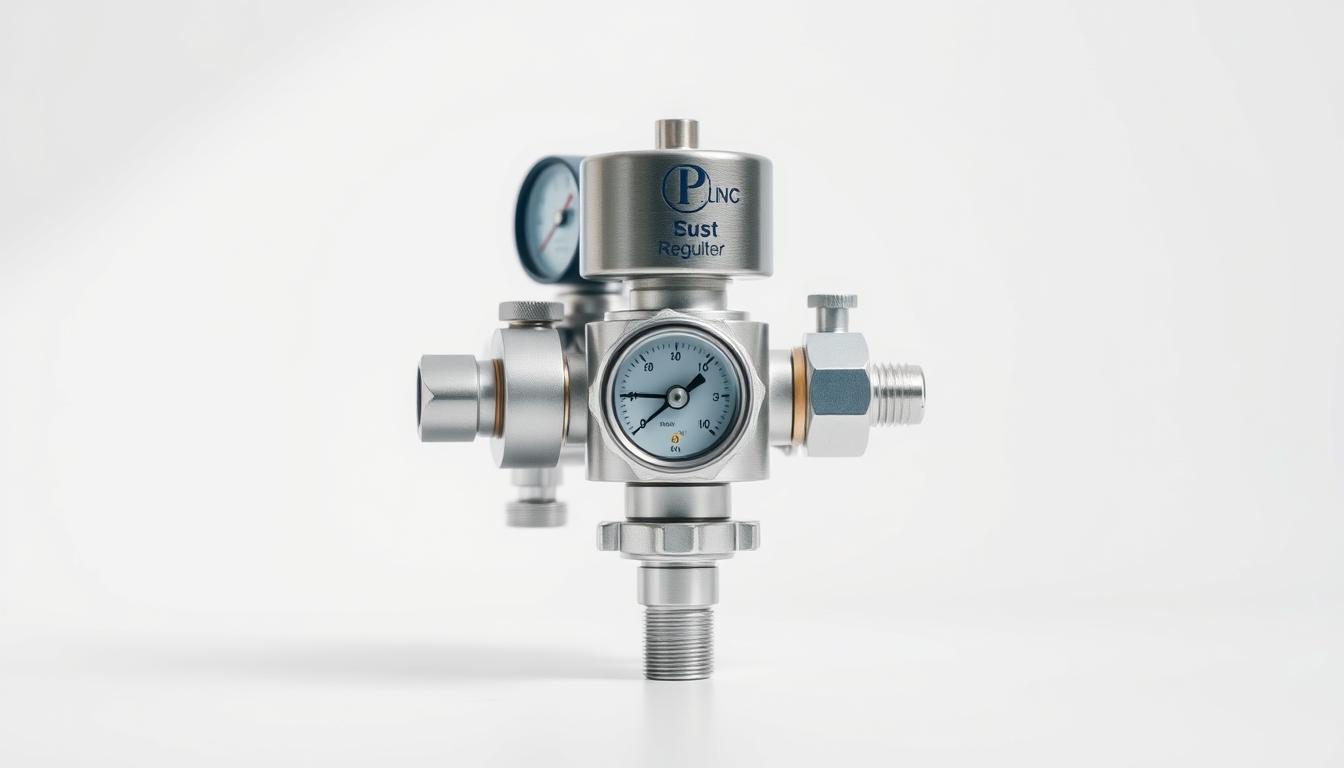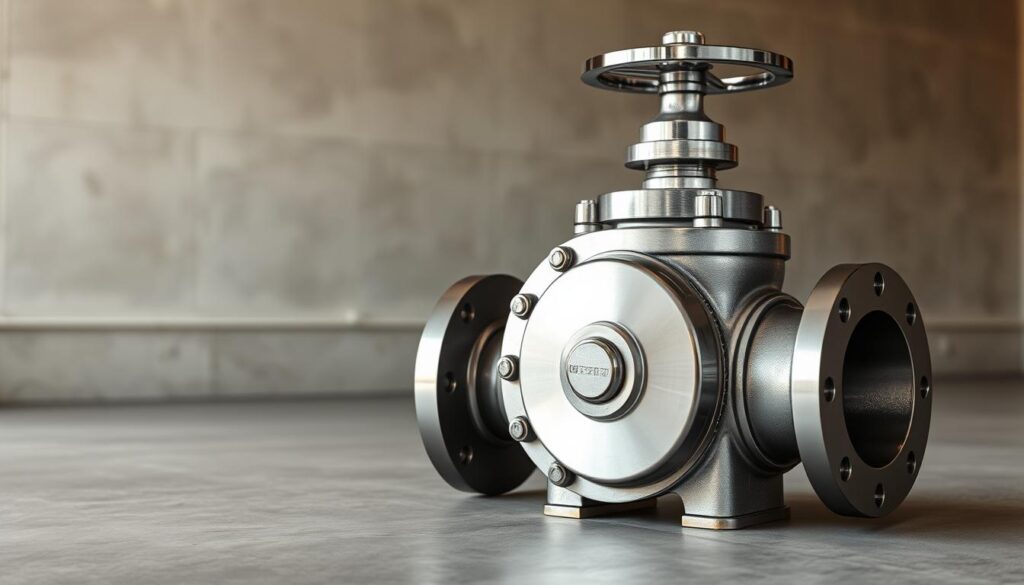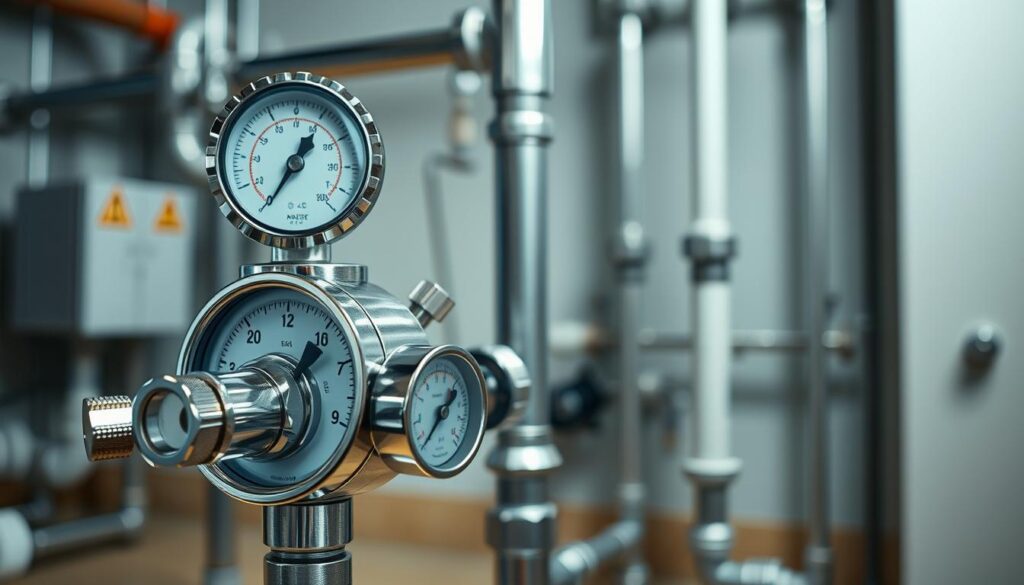
Could a simple valve be the reason your fixtures wear out faster than they should?
We are Lord Mechanical LTD, serving North and West Vancouver with clear, practical guidance for homeowners and businesses. Stable supply levels protect fixtures, reduce leaks, and lower long‑term costs.
Municipal feeds can spike well above safe limits, and local elevation adds strain on plumbing systems. A correctly set regulator sits just after the main shut‑off and uses a spring‑loaded diaphragm and adjustment screw to cut spikes and steady flow.
Most fixtures perform best near 50 psi; many local supplies reach 150–200 psi at times. We explain how to test at a hose bib, when to adjust or replace a valve, and why many units last roughly 4–12 years.
If you prefer a pro, call us at 604-670-3737 for fast inspection, reliable installs, and clear advice to protect your home and business.
Key Takeaways
- Stable supply reduces leaks and extends appliance life.
- A regulator is installed after the main shut‑off on the service line.
- Ideal operating range for most fixtures is about 50 psi.
- Test at an outside tap with a gauge to check performance.
- Regulators typically last 4–12 years; many recommend replacement near five years.
- Call Lord Mechanical LTD at 604‑670‑3737 for expert help in North and West Vancouver.
Why water pressure matters in North Vancouver homes
In North Vancouver, uneven supply at different elevations can harm plumbing and shorten fixture life. High mains at lower streets can reach 150–200 psi and stress valves, faucets, and fittings.
High water pressure risks:
High water risks: leaks, hammer, and appliance damage
Excess force speeds wear on pipes and fixtures. You may hear thumps or vibrations in walls — a sign of water hammer.
Appliances like dishwashers and clothes washers suffer when seals and internal valves are overstressed. Over time this raises usage and the chance of burst fittings.
Low flow signs and what they indicate
If both hot and cold are weak, a failed PRV or supply issue is likely. If only hot is weak, the heater is the usual suspect.
Fluctuating service often points to a failing regulator or municipal swings that your system can no longer buffer. Loud, chattering pipes call for a gauge test and inspection.
| Symptom | Likely cause | Action |
|---|---|---|
| Thumps or vibrations | Excess force causing water hammer | Test with gauge; check arrestors and supports |
| Constant leaks or running toilet | Overstressed fittings or failed valve | Measure at hose bib; consider PRV service or replacement |
| Weak cold and hot | Supply issue or failing regulator | Call us for a quick assessment and diagnosis |
| Only hot weak | Water heater issue | Inspect heater elements, valves, and sediment |
If you recognise these signs, call us at 604-670-3737. We measure, diagnose, and correct the root cause to protect your home and appliances.
What is a water pressure regulator (PRV) and how it works
The dome‑shaped brass device just after your main shut‑off is a water pressure regulator. It protects plumbing and fixtures by keeping outlet force steady.
Inside, a spring‑loaded diaphragm senses inlet changes and moves to narrow or widen the flow passage. Turning the adjustment screw changes spring tension and changes the regulated outlet value.
- Spike response: when inlet spikes, the diaphragm compresses and the valve constricts to lower outlet force.
- Drop response: when supply dips, the spring opens the passage to sustain delivery to taps and appliances.
“A well‑set regulator smooths municipal swings and reduces wear across your whole home.”
| Component | Function | When to act |
|---|---|---|
| Diaphragm | Senses inlet changes and modulates flow | No change in outlet when screw turned — inspect |
| Spring & screw | Set target outlet by adjusting tension | Loose or frozen screw — service or replace |
| Valve body | Channels flow and protects downstream systems | Leaking or corroded body — replace |
We recommend a gauge test if you notice swings or noisy pipes. Call Lord Mechanical LTD at 604‑670‑3737 for a quick assessment and safe calibration or replacement.
Ideal PSI for home plumbing and when you need a PRV
Most homes perform best when outlet force is tuned to a steady 50 psi.
An acceptable range for comfort and fixture life is roughly 40–60 psi. Staying in that band reduces wear on faucets, valves, and appliances.
If your home water pressure regularly exceeds 80 psi, many building codes require a pressure regulator. High water supplies in Metro Vancouver can spike to 150–200 psi, so momentary surges matter even if averages look normal.
We recommend a simple gauge test to confirm where your system sits. A regulator helps hold downstream values near the 50 psi target and smooths swings during heavy morning and evening use.
- Sweet spot: ~50 psi (acceptable 40–60 psi)
- Code action: install a pressure regulator if readings exceed 80 psi
- Local risk: low‑elevation homes may see higher supplies and need earlier intervention
| Condition | Typical PSI | Recommended Action |
|---|---|---|
| Normal household use | 40–60 psi | Maintain current setting; test annually |
| Consistent high readings | >80 psi | Install or service a pressure regulator |
| Momentary spikes | Up to 150–200 psi | Gauge test and consider surge-capable regulator |
Unsure of your reading? Call us at 604-670-3737. We test, set the right PSI for your home, and ensure installations meet local expectations in North and West Vancouver.
Where PRVs are installed: main water line and main shut-off valve
Locate the entry assembly by starting at the main shut-off valve where the service enters your home. The device is usually fitted immediately downstream on the main water line.
In colder climates the assembly sits indoors. Common spots are a mechanical room, basement, garage, or an insulated crawlspace. If you have a meter, look just after it; the flow arrow on the body points toward the home.

If the regulator isn’t visible after the shut-off, one may not be installed — that raises risk from elevated supply.
- Look for a bell‑shaped body on the main water line immediately downstream of the main shut-off valve.
- Townhomes and commercial units may hide the valve behind access panels — check inspection reports.
- Ensure straight pipe before and after the device for stable operation and easy servicing.
“Protecting the entry point protects every fixture downstream.”
| Location | Why it’s used | Action |
|---|---|---|
| After main shut-off valve | Protects all downstream branches | Confirm presence; service if corroded |
| Near meter or entry point | Accessible and central | Check flow arrow; label for future checks |
| Indoor/insulated area | Prevents freezing in winter | Relocate if exposed or hard to service |
We can locate, label, and service your main shut-off valve and water pressure regulator. Call us at 604-670-3737 for fast, local help in North and West Vancouver.
How to test home water pressure with a pressure gauge
Testing your home’s supply with a simple gauge gives quick insight into system health. We outline safe, repeatable steps so you can measure confidently before we adjust or replace any components.
Step-by-step testing at hose bibs and laundry faucets
Attach a threaded gauge to an accessible hose or the cold laundry tap. Make sure the connection is snug to avoid leaks and false readings.
Confirm no other taps or appliances are running. Open the cold tap slowly and note the reading. A stable 40–60 psi is ideal; anything above 80 psi suggests a control device is needed.
Interpreting readings and daily fluctuations
Repeat the test at different times of day. Municipal systems often show higher numbers at night when demand is low.
- If readings jump or drift, record the pattern — that can indicate a failing regulator or supply variability.
- Test both lower and upper floors in multi-storey homes to spot elevation effects.
- If the needle creeps after closing the tap, note it — thermal expansion or faulty valves may be at play.
Cold-climate considerations for North Vancouver
If exterior hose bibs are winterised, test indoors at the washing machine connection to avoid freeze risk. Take multiple readings over several days to capture typical behaviour.
We can bring calibrated gauges, log results, and inspect nearby valves. Call us at 604-670-3737 for a professional test and clear advice for North and West Vancouver homes.
Water pressure regulation
Whole-home control of incoming supply makes daily use predictable — for showers, dishwashers and irrigation alike.
A properly set water pressure regulator smooths municipal swings and protects valves, faucets, and appliances across the entire plumbing network.
Because the device manages the service entry, it prevents the stop‑start surges that cause noise and wear. That leads to quieter operation and fewer unexpected failures.
Stable delivery also balances flow during simultaneous uses so showers and appliances run without big drops. For light commercial sites, it protects solenoid valves and sensitive equipment.
- Consistent performance across every branch and fixture.
- Reduced strain on solder joints, connectors and hoses.
- Complements aerators, low‑flow fixtures and smart appliances for efficiency.
We assess existing hardware, check for corrosion or mineral build‑up, and confirm the unit is sized and oriented correctly. When pipe runs or bends limit flow stability, we recommend small layout tweaks.
“A well‑set regulator is the foundation of reliable plumbing and home comfort.”
Call us at 604‑670‑3737 for an on‑site check, periodic tuning, or fast service in North and West Vancouver.
How to adjust a water pressure regulator safely
Begin with a quick visual check of the regulator located just after your main shut‑off. Confirm no taps or appliances are running and have a calibrated gauge to hand.
Safety first: wear eye protection, keep hands clear of pipe joints, and shut off the main if you find leaks or heavy corrosion.
Loosening the locknut and turning the adjustment screw
Carefully loosen the locknut so the adjustment screw turns freely. Turn clockwise to raise outlet values and counter‑clockwise to lower them.
Small increments, re‑testing PSI, and avoiding over‑adjustment
- Make small moves — about a quarter turn — then open a nearby tap and read psi once the system steadies.
- Record each change so you can return to a known setting if needed.
- Avoid big or fast turns; they can create noise, brief hammer, or unstable delivery.
When adjustment fails and a replacement is due
If the screw bottoms out or multiple turns give no gauge change, internal wear, debris, or a failed diaphragm and spring may be to blame.
“If anything feels uncertain, call us at 604‑670‑3737 and we’ll adjust, verify the psi, and document the final setting for you.”
We can also re‑check at different times of day to confirm stability and ensure the unit holds the desired outlet value over time.
Installing or replacing a water pressure regulator
When a regulator needs replacing, the choice between DIY and a licensed plumber comes down to skill and risk tolerance.
DIY vs. licensed plumber: tools, skills, and safety
Locate the device directly after the main shut-off valve on the main water line so the whole building benefits.
For a DIY install, shut off the main and drain the nearest tap first. Gather a pipe cutter, grit cloth, flux paste, solder, torch, Channellock pliers and threaded couplings.
Tip: verify the regulator’s flow arrow points toward the home before final fitting.
Cutting pipe, couplings, soldering, and leak checks
Measure twice and cut once. Leave enough straight pipe to seat couplings and clean ends thoroughly with a grit cloth.
- Apply flux, heat fittings evenly, and draw solder into joints for a solid seal.
- Tighten unions or couplings, reopen the main slowly, and bleed air at a nearby tap.
- Inspect all joints for seepage and re‑tighten if needed.
Replacement jobs are simpler: loosen unions, swap the body, and re‑pressurise while watching for leaks. Tight spaces may need valve relocation or slight pipe reconfiguration to meet code and permit easy service access.
“We commission each install by setting outlet values, verifying performance at key fixtures, and documenting final readings.”
Pros of hiring a pro: a licensed plumber brings tested techniques, parts sourcing, and calibrated tools. Typical install costs in our area run about $250–$450, with regulators priced $50–$200 depending on model.
If you want a no‑hassle install and warranty‑backed work in North and West Vancouver, call us at 604‑670‑3737. We handle sourcing, neat installs, commissioning and clean‑up so your system performs reliably.
Common issues: high, low, or fluctuating water pressure
Household plumbing faults often begin with odd noises, sudden swings, or weak flow at taps. We help you isolate causes quickly so you can act decisively.
Diagnosing noisy pipes, water hammer, and leaky joints
Loud thumps, vibration, or chattering in the pipes suggest water hammer. Check supports and arrestors, and also verify the regulator near the entry for abnormal noise.
If you see pooling under the device or damp drywall, act fast. Leaks often start at stressed joints and flexible connectors when fills run too strong for too long.
Differentiating PRV problems from heater or valve issues
If both hot and cold are weak, suspect the pressure regulator or incoming supply. If only hot is weak, inspect the water heater, its valves, and filters instead.
“A quick set of timed gauge readings at several taps separates wide supply faults from isolated fixture problems.”
- If a gauge swings with no fixtures on, the regulator may not buffer incoming water pressure.
- Very high readings at taps point to a stuck-open device that can harm appliances and fixtures.
- Mineral build-up can cause low readings or surging by limiting internal travel.
| Symptom | Likely cause | Immediate action |
|---|---|---|
| Gauge swings while idle | Failing regulator or supply variability | Record readings over time; call for diagnostic testing |
| Loud thumps or chattering | Water hammer or poor support | Check arrestors, brace pipes, verify regulator function |
| Very high tap readings | Stuck-open regulator | Shut off main if needed; call for repair to protect fixtures |
| Only hot weak | Heater or its valves/filters | Inspect heater; replace filters or service elements |
We diagnose quickly and propose targeted remedies—adjust, service, or replace—so your home returns to steady, quiet operation. Call Lord Mechanical LTD at 604-670-3737 for fast diagnostics in North and West Vancouver.
Cost, savings, and ROI for PRV installation in Canada
A single correctly sized unit can protect every fixture and appliance in your home. The decision to install should balance upfront cost against long‑term savings from fewer leaks, quieter operation, and longer appliance life.
Typical regulator and installation pricing
Expect the regulator itself to range from about $50–$200, depending on line size and brand. Professional labour in Canada typically adds roughly $250–$450, with tight spaces or relocations pushing costs higher.
Water and energy savings from stabilised PSI
Stabilising delivery cuts needless flow during use. Many homeowners report meaningful reductions in consumption—claims of up to about 30% in some cases—mainly by eliminating surges and over‑flow from fixtures.
- ROI drivers: avoided water damage, fewer early appliance failures, and lower utility bills.
- Landlords & strata: fewer callbacks and reduced long‑term maintenance costs.
- Businesses: steady service protects solenoid valves and reduces downtime.
| Item | Typical cost (CAD) | Benefit |
|---|---|---|
| Regulator unit | $50–$200 | Protects fixtures and appliances; long service life |
| Professional installation | $250–$450 | Correct sizing, commissioning, and warranty‑grade work |
| Annual testing & tuning | $80–$150 | Maintains optimal settings and verifies savings |
| Replacement (end of life) | $200–$500 installed | Prevents failure and avoids costly water damage repairs |
We size and source the right model for your line and usage profile, commission the install, and verify the result so you start with a documented baseline.
“A modest investment at the entry can prevent major repair bills later.”
Call us at 604‑670‑3737 for a tailored quote that reflects North and West Vancouver labour and materials. We package testing, installation, and follow‑up checks for a predictable total cost of ownership.
Lifespan, maintenance, and when to replace your PRV
Planning ahead avoids surprise failures when you need taps and appliances most.
Most valves last about 4–12 years, with many makers advising replacement at roughly the five‑year mark. That guideline limits creeping high pressure and the risk of sudden faults.
Test annually to confirm the outlet stays at your chosen set point across seasons. If the adjustment screw no longer changes readings, internal wear usually means it’s time to replace water pressure.
Warning signs to act on sooner include leaks, loud hammering, or broad high or low readings throughout your home. Proactive replacement reduces surprise failures during holidays or cold snaps.
Keep a simple log of install dates, set points, and service visits. We can add your unit to a maintenance calendar and handle annual checks, adjustments, or full replacement when needed.
“Planned care keeps systems quiet, safe, and reliable.”
- We match brand and size to minimise rework.
- After any swap we test, document, and review the result with you.
- Call us at 604-670-3737 to schedule proactive service in North and West Vancouver.
Choosing the right pressure regulator for your home
A good start is matching the unit to your pipe size and peak flow needs. That prevents choke points at busy times while keeping fixtures safe.

Sizing, materials, and diaphragm quality
Size matters: pick a model that matches your main line (common options are 3/4″ and 1″) so you preserve flow without excessive drops.
Materials and safety: lead‑free brass bodies and reinforced diaphragms extend life and meet potable standards. Reputable brands like Watts supply easy‑to‑find 3/4″ and 1″ units that suit most local homes.
- Confirm the flow arrow points the right way on installation.
- Choose valves with unions or isolation valves nearby for easy servicing.
- Select models with serviceable strainers if your area has mineral‑rich supply.
- For higher demand or light commercial use, pick regulators rated to hold set points across a wide flow range.
“A correctly sized unit saves hassles and helps fixtures last longer.”
We evaluate your building type and municipal feed, then match and install the right pressure regulator for reliable, code‑aligned performance in North and West Vancouver. Call us at 6046703737.
Professional help in North Vancouver: when to call a plumber
If you notice sudden swings, leaks near unions, or taps that won’t stabilise, a licensed plumber can save you time and costly repairs.
DIY work carries real risk. Installations often need relocating the main shut-off valve to create safe access and meet code. We verify flow direction, set the outlet, and check every joint for leaks.
Typical install cost runs near $350 in our area. We bring calibrated gauges and parts so final readings are accurate and repeatable under real use.
- Call a plumber when swings persist, the regulator won’t adjust, or leaks appear near the body or unions.
- If you can’t locate the main shut-off valve or safely isolate the line, get professional help to prevent flooding.
- Tight spaces, corroded fittings, or awkward layouts often demand experience to reposition components correctly.
- For stratas and businesses we provide scheduling, documentation, and compliance records.
“We set, test, and document each pressure regulator installed so your home stays quiet, stable, and leak‑free.”
| Service | What we do | Typical cost |
|---|---|---|
| Diagnostic & gauge test | Calibrated readings at key taps | $80–$150 |
| Regulator install | Fit, orient, set outlet and leak check | ≈ $350 |
| Replacement & commissioning | Swap unit, test under load, document results | $200–$500 |
If high water is stressing your system, call Lord Mechanical LTD at 604-670-3737 for fast, expert service across North and West Vancouver.
Conclusion
Start by measuring outlet force at a hose or laundry tap to understand how your system actually behaves.
Use a calibrated pressure gauge, aim for about 50 psi, and record readings at different times. If numbers exceed 80 or show frequent spikes, a pressure regulator fitted just after the main shut-off valve on the main line is the right protection for pipes, valves and appliances.
Adjust the screw in small steps. If turns don’t change readings, plan to replace the unit—diaphragm or spring wear often causes failure after 4–12 years.
Need help? We test, set, or swap your water pressure regulator and document final readings. Call Lord Mechanical LTD at 604-670-3737 for fast local service in North and West Vancouver.

